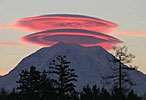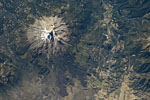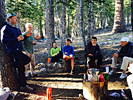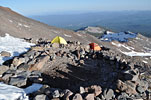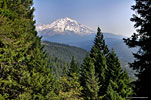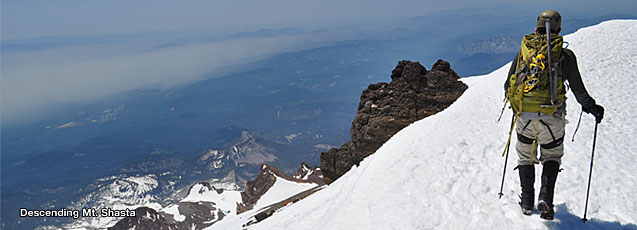 |
|
Mt. Shasta, Shasta-Trinity Nat'l. Forest, Northern California |
 |
| Just wow! Anyone who has driven I-5 through Northern California Mt. Shasta is one of fifteen California "14'ers" - peaks over 14,000'. Only two of these, Mt. Shasta and White Mountain Peak, are outside the Sierra Nevada range in Central California. Mt. Shasta is only 50 miles south of the Oregon border and is part of the Cascade range, its 2nd highest peak after Mt. Rainier in Washington state, which is only 250' higher. What distinguishes Mt. Shasta is it's vertical prominence above the surrounding landscape. At 14,179' (4,322m), it's unmistakable dome rises 10,000' above the rolling hills of Northern California and can be seen from up to 100 miles away. In contrast, the highest peak in the contiguous USA, 14,497' Mt. Whitney, 450 miles south, is difficult to distinguish from the surrounding peaks from below, evenMt. Shasta makes its own weather, scraping the sky and churning the air around it, its summit plain covered with snow year round. The strong winds across Shasta's summit often create unusual and beautiful lenticular clouds which are routinely described as UFO's! Legends |
Mt. Shasta the town The last time Shasta erupted was thought to be in the late 1700's, when a Just below the summit is an area of volcanic activity called Shasta Springs, where there's an active fumerole of sulphuric gas that has scalded the rocks into ash. The odor wafts across the summit to remind all climbers that the mountain could erupt again at any time. Famed writer/wilderness activist John Muir climbed Shasta has 7 active glaciers which hold a year round snow base for backcountry ski adventurers. The multi-year drought California is enduring has drastically reduced the snow levels on Mt. Shasta, so much that the Mt. Shasta ski area is going out of business. |
| Avalanche Gulch Avalanche Gulch isn't a technical climb, but alpine boots, crampons and ice axe are essential year round. The most challenging obstacle of this route is a barrier of high cliffs called Red Banks, covered with snow and ice much of the year. From Bunny Flats trailhead, the Avalanche Gulch route to the summit is only about 6 miles, but it's a 7,300' elevation gain through snow, ice and loose, crumbling volcanic rock. The time for the ascent depends on the pace but sources report between 8-10 hours for the ascent and 4-5 for the descent. Many Avalanche Gulch climbers make their overnight basecamp at or near 10,400' Helen Lake, a flat spot below the Red Bank cliffs, then depart for the summit before dawn and return to the trailhead at Bunny Flats the same day. Guides |
Two local year round guide services, Shasta Mountain Guides and SWS Mountain Guides, both offer similar guided group 3 day outings via Avalanche Gulch in the $500-$600 per person range (2014), as well as other custom-tailored climbs. Although the climb can be done in 2 days or less, 3 days gives more time to acclimate to the altitude, to get accustomed to the rigorous climb using rented boots, crampons and axes, to practice safety and climbing techiques like self-arrest and glissading, and mainly to enjoy and appreciate the majestic setting at a less demanding pace. In addition to their years of successful summiting and thorough knowledge of the mountain, the guide companies often lead multiple groups simultaneously, and connected by radio, they can communicate conditions and recommend to each other the best routes up and down in real time. They provide breakfast and dinner (bring your own lunch), climbing harness, and take care of acquiring permits and passes and camping fees (Horse Camp). The required ice axe, alpine boots, leg gaitors (prevent snow from getting in boots) and crampons are typically rented locally, as well as any/all gear, apparel and accessories needed. |
A journal of planning and summiting Mt. Shasta, with some info that may be helpful to those considering their first summit attempt. If you only have a few minutes, you'll probably find Day 3 the most interesting. |
I'm usually a self-supported solo hiker, but for my first high altitude ice climb, I'll join up with a guided group. I have a lot of questions about gear and  method and logistics, fairly certain more than anyone would be willing to answer! Both of the local full-time guide companies, SWS Guides and Shasta Mountain Guides, have good websites with a lot of info. SWS also has many YouTube videos about technique and gear and I spent a lot of time online to weed out my lamest questions. Also I research climbing boots, comparing stiffer insulated double plastic vs. leather shells, and the practicality of purchasing vs. renting. For those who don't method and logistics, fairly certain more than anyone would be willing to answer! Both of the local full-time guide companies, SWS Guides and Shasta Mountain Guides, have good websites with a lot of info. SWS also has many YouTube videos about technique and gear and I spent a lot of time online to weed out my lamest questions. Also I research climbing boots, comparing stiffer insulated double plastic vs. leather shells, and the practicality of purchasing vs. renting. For those who don't  know, climbing boots are extremely rigid with a shank sole that will hold steel crampons firmly in place for climbing on steep ice. Regular hiking boots don't cut it because the torqued stress between the crampons, boots and ankle from the weight of a climber and pack on steep ice is phenomenal. These alpine expedition style boots start new at over $600 and go into the thousands of dollars. They're rigid and tough enough to withstand all kinds of punishing terrain and conditions a mountain climber might encounter. The down-side is that most of the climb up the Avalanche Gulch route doesn't require crampons and hiking in stiff boots is hot, heavy and unwieldy. If you don't climb ice regularly, it's not cost-effective to buy a pair, so most climbing tourists like me will rent. know, climbing boots are extremely rigid with a shank sole that will hold steel crampons firmly in place for climbing on steep ice. Regular hiking boots don't cut it because the torqued stress between the crampons, boots and ankle from the weight of a climber and pack on steep ice is phenomenal. These alpine expedition style boots start new at over $600 and go into the thousands of dollars. They're rigid and tough enough to withstand all kinds of punishing terrain and conditions a mountain climber might encounter. The down-side is that most of the climb up the Avalanche Gulch route doesn't require crampons and hiking in stiff boots is hot, heavy and unwieldy. If you don't climb ice regularly, it's not cost-effective to buy a pair, so most climbing tourists like me will rent. |
In the first months of 2014, I spoke on the phone with SWS Guides at length and the gentleman (whose name I forgot) was extremely patient and helpful in answering all my questions. Equally helpful was Chris Carr, the owner of Shasta Mtn. Guides, and his wife Jenn. It's a tough "choose-me" business because they have to take their time answering a myriad of first-timer questions from potential customers to close the deal, without being curt or demeaning. Then there's buying a plane ticket to Redding (the nearest mid-size airport), getting a rental car and booking a room for the first and last nights of the trip. |
| Day 1Friday June 6Bunny Flats to Horse Camp 1.6 miles, 1000ft. elevation | ||||||
|
| Day 2June 7Horse Flats to Helen Lake 2.5 mi., 2500ft elevation | |||||||
|
| Day 3Sunday June 8Helen Lake to summit to Helen Lake to Horse Camp to Bunny Flat trailhead | |||||||||||
|

|
Permits, Passes Summit Passes ($15 per person/$20 for 3-day permit) are required for everyone over age 16 who climbing above 10,000'. (Under 16 free) Passes may be obtained at USFS offices, The Fifth Season gear shop and at self-serve kiosks at the major trailheads. Human waste packout |
|
||
| |||
| On the trail | |||||
 Day 1, Fri. morning: Gear check by our guide company, who run several groups up the mountain most weekends |
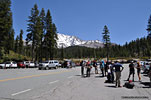 Bunny Flat, the trailhead at 6950' where our group of 6 climbers, 1 lead guide & 2 co-guides meet up. Our group is all ages, all experienced hikers. |
 It's warm and clear and the weather forecast is ideal for the summit attempt 2 days away |
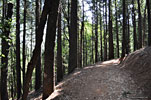 The first miles are a steady break-in climb through shady forest. Lead guide Joe keeps a slow gait so we can adjust to our clunky alpine boots, and the altitude The first miles are a steady break-in climb through shady forest. Lead guide Joe keeps a slow gait so we can adjust to our clunky alpine boots, and the altitude |
 After 3 hrs, we reach Horse Camp, where there's a Sierra Club cabin (and composting toilet!), and not much else. We set up our tents at camp sites in the adjacent woods After 3 hrs, we reach Horse Camp, where there's a Sierra Club cabin (and composting toilet!), and not much else. We set up our tents at camp sites in the adjacent woods |
 We study our route up Avalanche Gulch. Tomorrow we climb to Helen Lake, the plateau where the snow stops in the center of the picture |
 After dinner, there is time to learn about the mystical Lemurians who inhabit the mtn. I stay up to try to spot one... |
 Day 2: All of the groups begin climbing slowly out of treeline, the first mile on a stone path called Olbermans Causeway Day 2: All of the groups begin climbing slowly out of treeline, the first mile on a stone path called Olbermans Causeway |
 It's soon very hot. After 3 miles, we get off the dusty trail & switch to the snow route to cool off. Others follow |
 You can see the 2 plateaus below Red Banks. Helen Lk, is the higher of the two, still a long tough climb above us... |
 We take breaks every hour, but by mid afternoon, we're all beat from the exertion, heat and thin air We take breaks every hour, but by mid afternoon, we're all beat from the exertion, heat and thin air |
 A pair of glissaders slide past us. Here's the video. If it doesn't auto-play in your browser, right click the link to download |
 The summit is behind the ridgeline and can't be seen until we're much higher on the mountain |
 Finally, we make it to Helen Lake, a flat spot on the slope, our destination for today's hike |
 Helen Lake will be our base camp. My tent is the yellow one, top center. A park ranger stays up here during the season in the tan tent at right |
 Red Banks is the strip of cliffs across the center of the ridge. We'll turn right halfway up and climb the right side, where some climbers are descending |
 Helen Lake is a seriously tough climb and its only half way to the top. We're all exhausted! One of the guys bows out of tomorrows climb & will wait here for our return. After a welcome break, we gather on a steep slope to practice roped-climbing, self-arrest with ice axe and glissading. |
|
 We'll set out up this huge bowl by headlamp at 2am in freezing temperature, roped together in 3 groups of 3. All the snow melting in the midday sun will have turned to ice overnight |
 Room with a view |
 West below Helen Lake, other climbers settle in on the lower plateau |
 Day 3: After 3 hours of surreally quiet ice climbing in the pitch black predawn, our world slowly rotates in to the sun. Half a dozen groups are all climbing at the same time, some straight up, others zigzagging up like us |
 This pic shows a little bit of how steep this slope is. It's sheer ice, impossible without crampons. We have to chip sitting ledges out of the ice with our axes. One slip would send you hurtling thousands of feet down the slope This pic shows a little bit of how steep this slope is. It's sheer ice, impossible without crampons. We have to chip sitting ledges out of the ice with our axes. One slip would send you hurtling thousands of feet down the slope |
 Shasta's peak shadow appears over the western landscape Shasta's peak shadow appears over the western landscape |
 Several times someone above yells "rock!" and all the groups immediately hunker down, straining to sight the dislodged projectile before it clobbers us |
 Four hours and we've climbed above Red Banks. |
 Walking with crampons is unlike any other activity. Your foot is never flat on the surface, so the strain on calves is phenomenal |
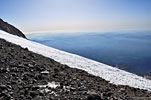 View SW, climbing above Red Banks through 13,000' |
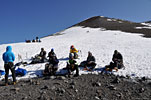 Misery Hill is the last impediment, so called because it presents its very steep grade when everyone is exhausted from the exertion in thin air Misery Hill is the last impediment, so called because it presents its very steep grade when everyone is exhausted from the exertion in thin air |
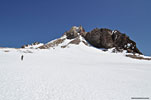 At the top of Misery Hill, we see the actual summit for the first time, across a big snow field. It's still another significant climb |
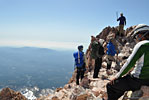 Finally on top, 9 hours later. The first in our group queue to stand on the highest spot |
 Most of the climbers on the mtn. reach the summit about the same time, because it's wise to get down before afternoon weather arrives |
 This northeast view shows a bit of the size of the summit. The east side is a looming dropoff |
 The big summit snowfield tapers down to the pinnacle of Misery Hill, where you can see climbers silhouetted. |
 Our tired but jubilant crew. There was no wind at all, and our experienced lead guide Joe (top row, 3rd from L) said it was the nicest he'd ever seen it |
 The gray rock area at right is an active volcanic fumerole with steam vents, hot rocks and a strong sulphur odor |
 Traffic jam. Guide Pearson recognized famed free-climber Alex Honnold on the summit and we chatted some |
 The summit is only half way - now we'll return to basecamp, break camp and hike all the way out before dark The summit is only half way - now we'll return to basecamp, break camp and hike all the way out before dark |
 Climbing down from the summit, there's really no path to speak of and it's very steep, loose rock Climbing down from the summit, there's really no path to speak of and it's very steep, loose rock |
 You can see how the snowfield funnels everyone to the top of Misery Hill |
 The top of Whitney glacier, one of nine on Mt. Shasta The top of Whitney glacier, one of nine on Mt. Shasta |
 The trek down is the when we really get to enjoy the spectacular view |
 View northwest View northwest |
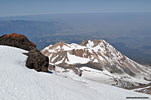 12,329' Shastina is a sub peak, but the 3rd highest in the Cascade range. You can see its clearly formed volcanic caldera 12,329' Shastina is a sub peak, but the 3rd highest in the Cascade range. You can see its clearly formed volcanic caldera |
 |
 |
 |
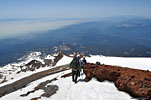 The steep slope above Misery Hill leading down to the Red Banks |
 Making our way down from Misery Hill |
 Above Red Banks, we choose a different descent route than the one we took up, turning to the right just before the peak called Thumb Rock Above Red Banks, we choose a different descent route than the one we took up, turning to the right just before the peak called Thumb Rock |
 This pic shows how steep the slope is we ascended and descended. Guide Pearson (L) kept things lively and fun |
 You can see a solo climber (left of top ctr.) making his way down the snowfield above Red Banks You can see a solo climber (left of top ctr.) making his way down the snowfield above Red Banks |
 Slipping through a crack |
 The Red Banks of Mt. Shasta The Red Banks of Mt. Shasta |
 Below Red Banks, we enter the big bowl above Helen Lake once again Below Red Banks, we enter the big bowl above Helen Lake once again |
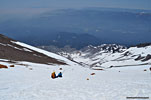 A pair of climbers glissading A pair of climbers glissading |
 After some glissading and lots of walking/postholing through deep snow, all of our group slowly straggle back to camp After some glissading and lots of walking/postholing through deep snow, all of our group slowly straggle back to camp |
 After breaking camp, we begin the long journey out, fully loaded with all our gear After breaking camp, we begin the long journey out, fully loaded with all our gear |
 Some try more glissading (ctr. left) on the way out, but its hot now and the snow has already melted enough to make it more of an exertion than walking Some try more glissading (ctr. left) on the way out, but its hot now and the snow has already melted enough to make it more of an exertion than walking |
 We took the snow route up to Helen Lake, but coming down is easier on the established dirt path We took the snow route up to Helen Lake, but coming down is easier on the established dirt path |
 After many hot hours of alpine descent, approaching the welcoming shade of treeline again After many hot hours of alpine descent, approaching the welcoming shade of treeline again |
 Returning to Horse Camp on the Olberman Causeway Returning to Horse Camp on the Olberman Causeway |
 Exhausted summiteers from many different groups Exhausted summiteers from many different groups |
|||
More photos in the Trip Report top of page
TOP![]() Hikes Index
Hikes Index
Since Oct.2014


